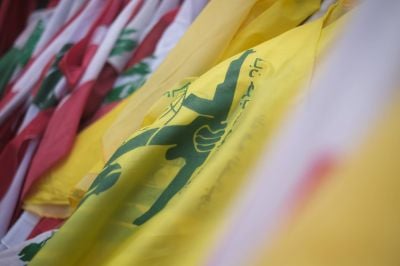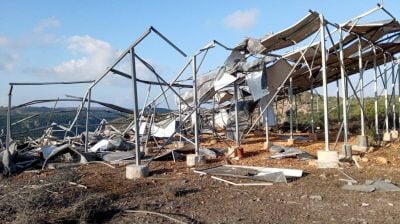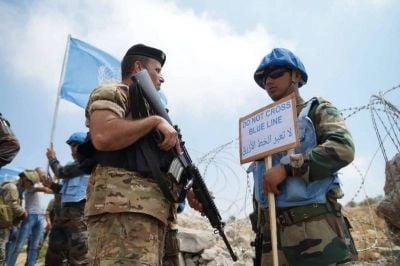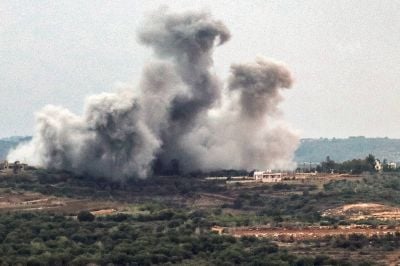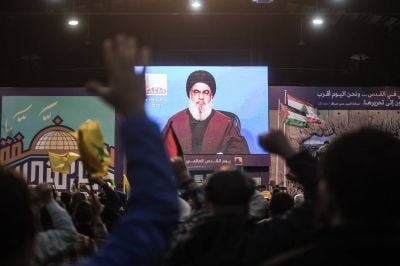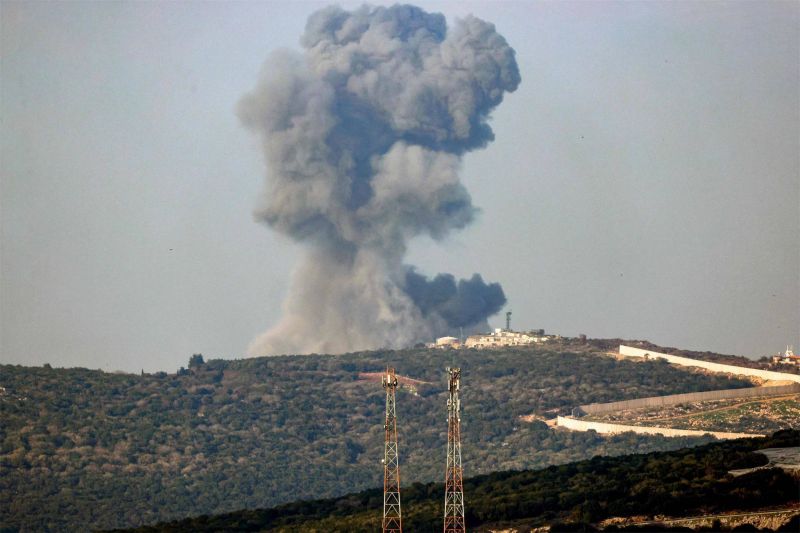
An Israeli bombardment in the Lebanese village of Aita al-Shaab. (Credit: Jalaa Marey/AFP)
What if Operation al-Aqsa Flood had been carried out not by Hamas from Gaza, but by Hezbollah from southern Lebanon? How far could the members of the party’s special operations forces unit, the Hajj Radwan Force, have advanced into enemy territory?
Such a scenario appears to have preoccupied the Israeli security apparatus since Oct. 7.
Following the deadliest attack in its history, Israel faces a strategic dilemma: how to restore its deterrent capacity against the entire “axis of resistance” — and not just Hamas — without triggering a regional war that it cannot wage alone, and one that its main ally, the United States, is actively working to avoid.
Even if Israel manages a military defeat against Hamas in the Gaza Strip — a goal that remains distant — it will still confront a force 10 times more powerful on its northern border.
Admittedly, this is nothing new. Israel has always perceived Hezbollah as the main threat to its security for years, without this having any impact on the stability of the Lebanese-Israeli border between Aug. 14, 2006 (which marked the end of the 2006 war between the two sides) and Oct. 8, 2023.
Hezbollah’s approach over these 17 years and its relative restraint since Oct. 7 has somehow calmed Israel’s fears as to the party’s military intentions.
Hezbollah did nothing before Oct. 7 to start a war against its enemy and has done everything — within the limits of its logic — to avoid it ever since.
The Israelis might not perceive Hezbollah in the same light as Hamas, possibly arguing that the party appears more committed to preserving its influence in Lebanon and the broader Middle East than prioritizing the “liberation” of Palestine.
Tel Aviv might also posit that if Hezbollah wanted to join Hamas’ brutal attack, it might have done so on Oct. 7, and that in any case, an operation of such scale is very unlikely to be repeated.
The Israelis, however, do not seem to think this.
Rather, they think they are engaged in an existential battle against Iran and its primary armed wing in the region.
Caught off guard by Hamas, whom they never considered capable of inflicting such a blow, they aim to capitalize on the current situation to, if not eliminate, at least diminish the threat they perceive from Hezbollah, particularly the 2,500 fighters of the Radwan force specializing in commando operations.
An ideal opportunity to undermine Hezbollah
Since Oct. 8, Israel has been executing a campaign in southern Lebanon with the objective of eliminating as many members of Hezbollah’s Radwan force as possible.
Hezbollah reported losing 119 fighters so far.
Simultaneously, Israel is making certain southern areas become uninhabitable in the short term, potentially paving the way for a ground invasion. It is consistently overstepping the rules of engagement, while Hezbollah continues to respond cautiously. Israel appears to be seeking to broaden the scope of its invasion and possibly provoke its adversary into a large-scale escalation.
After 77 days of war, the threat of Lebanon becoming the theater of a large-scale confrontation no longer comes from Hezbollah but from Israel.
Israeli officials, particularly Defense Minister Yoav Gallant, repeatedly state that in the absence of a political settlement pushing Hezbollah fighters north of the Litani River (as per UN Resolution 1701), they may resort to a military option.
Beyond Israeli Prime Minister Benjamin Netanyahu’s political calculations, with potential motivations to prolong or expand the war for his political survival, it is the members of the war cabinet who are strategically navigating the situation.
Following the Hamas attack, Gallant advocated for an Israeli response in Lebanon rather than Gaza to catch the enemy off guard. However, Netanyahu opposed this option due to significant pressure from the United States.
Benny Gantz, Yoav Gallant and Gadi Eisenkot, prominent figures in the Israeli war cabinet, appear to perceive a distinctive chance to undermine Hezbollah. They attribute this opportunity to the presence of American aircraft carriers in the region and the lack of civilians in the critical war zone on either side of the border.
Should the 70,000 displaced individuals on the Israeli side and the 60,000 on the Lebanese side return to their villages, executing such an operation for Israel would become significantly more challenging.
The ‘between wars’ campaign
Israel’s current campaign in southern Lebanon mirrors a strategy employed in Syria for several years. This approach involves precisely targeted strikes with the goal of diminishing the adversary’s operational capabilities, avoiding all-out war.
Former Chief of Staff of the Israeli army, Gadi Eisenkot, conceptualized this strategy, known as the “campaign between two wars.”
In a September 2019 article published by the Washington Institute for Near East Policy, Eisenkot detailed the strategy, aiming to “delay war,” “deter” and “weaken the enemy,” and establish “optimal conditions” for the Israeli army in preparation for potential conflict.
Since its implementation on Oct. 8, the “campaign between two wars” doctrine has been in action. While Israel has the option to escalate its campaign along similar lines, achieving its objectives through this approach alone appears doubtful.
However, this strategy could serve as a preliminary step for a potential ground operation with the goal of “securing” the entire area south of the Litani River, reminiscent of Israel’s invasion of southern Lebanon in 1978.
Jonathan Conricus, spokesperson for the Israeli forces, recently told The Times that the army has prepared and is preparing plans for a possible invasion of southern Lebanon.
However, Gallant currently leans toward the diplomatic option, acknowledging the complexities of such an operation.
The difficulty lies in at least three factors.
Firstly, unlike in Gaza, Israel would not have international support for this operation, with the US cautioning against such military ventures.
The pertinent question is: Can Israel undertake such an operation in southern Lebanon without Washington’s backing? Simultaneously, once a conflict has begun, would Washington hold the same stance toward its key ally in the region? The question of what the US response to an Israeli offensive in southern Lebanon and its potential participation in the war effort might be is currently difficult to answer.
Secondly, there is also Hezbollah’s formidable military arsenal, vastly different from Hamas’. With tens of thousands of missiles capable of reaching targets more than 100 kilometers away, Hezbollah poses a significant threat to Israel’s core areas. The party has so far refrained from using its missiles since Oct. 8. Despite the presence of the “Iron Dome,” the question remains: can Israel afford a war with potentially severe repercussions on its own territory?
Thirdly, there are concerns about the difficulty of disengaging from the war once it has started.
Hezbollah has exercised caution since Oct. 8, not just due to concerns about Israeli American reactions but also because it perceives itself as currently winning.
However, an Israeli military incursion would likely prompt Hezbollah to reassess its calculations. Even if Israel aims to restrict its operation to south of the Litani River, it’s challenging to envision Hezbollah refraining from deploying all its forces once Israeli troops enter Lebanese territory.
The question then arises: How can the operation be limited both in duration and geographical scope, given the potential escalation once Hezbollah actively engages in the conflict?
Two conditions
Defining realistic war objectives for such an operation in advance appears rather challenging. Because even if the Israelis manage to eliminate Hezbollah south of the Litani River and the party surrenders to such a scenario, what do they intend to do next?
Will they want to permanently occupy Lebanese territory? Or rely on the army or United Nations Interim Force in Lebanon (UNIFIL) to prevent Hezbollah from re-establishing itself in an area under its influence?
The 1982 Israeli invasion, with the help of the Syrian army, led to the dismantling of the Palestine Liberation Organization (PLO) in Lebanon.
But a ground incursion today poses much greater risks for Tel Aviv in a context where it cannot rely on any local allies and where Hezbollah is much more powerful than the PLO and much more integrated into the Lebanese social fabric.
Notably, Hezbollah was established following the Israeli invasion of Lebanon in 1982.
As things stand now, a diplomatic agreement now appears to be the best option, even for Israel. Hezbollah is not totally opposed to it, but it would need optimum conditions to be able to sell it to its supporters.
A possible agreement would have to include an Israeli withdrawal from the occupied territories and eventually resolving the land border disputes.
Is Hezbollah prepared to accept this, when the very essence of the “resistance” is based on Israel’s occupation of these territories?
Another and even more important stumbling block relates to the timing of such an agreement.
If the Israeli operation comes to an end in Gaza, Hezbollah could more easily claim victory and withdraw discreetly from the area south of the Litani River without appearing to lose face.
On the other hand, if Israel successfully destroys Hamas’ operational capabilities in the Gaza Strip, it would be challenging for the party to negotiate any agreement without seeming to concede to the enemy.
The US plays a pivotal role in this equation. It holds the potential to dissuade both Hezbollah and Israel from escalating into an all-out war, and it has the influence to compel Israel to halt its operation in Gaza.
Currently, Washington is pressuring Israel to transition to a lower-intensity phase of conflict starting in mid-January.
Will this be enough to create a favorable climate for an agreement in southern Lebanon? Now more than ever since Oct. 7, the fate of Lebanon seems to intertwine with that of Gaza.
This article was originally published in French in L'Orient-Le Jour. Translation by Sahar Ghoussoub.
